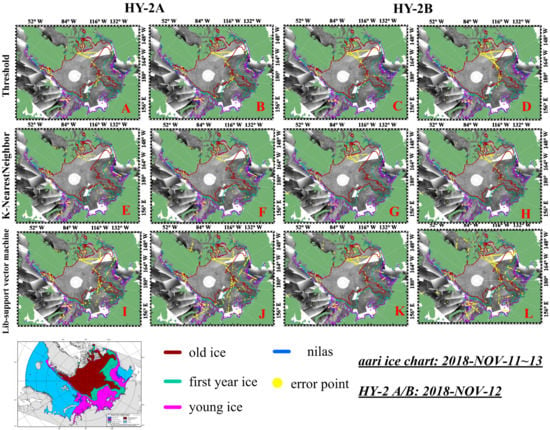A Study of the Technology Used to Distinguish Sea Ice and Seawater on the Haiyang-2A/B (HY-2A/B) Altimeter Data
Abstract
:1. Introduction
2. Data and Methods
2.1. HY-2A/2B
2.2. Other Data
2.2.1. HY-1C CCD Coastal Zone Imager (CZI)
2.2.2. OSISAF ICETYPE
2.2.3. Sentinel 1a/b
2.2.4. AARI Ice Chart
3. Characteristics of the Waveforms
3.1. Contrasts between the Features of the Typical Waveforms in the Polar Regions
3.2. Contrasts between the Different Tracking Packages
3.3. Classifying Parameters
3.4. Contrasts in the Parameters
3.4.1. Analysis of the 1 Hz Data
3.4.2. Analysis of the 20 Hz Data
4. Classification Process
4.1. Threshold Segmentation
4.2. K-Nearest-Neighbor (KNN)
4.3. Lib-Support Vector Machine (LibSVM)
5. Discussion
6. Conclusions
Author Contributions
Funding
Acknowledgments
Conflicts of Interest
Abbreviations
| AAGS | Average attitude/specular gate |
| AARI | Russian Arctic and Antarctic Research Institute |
| AGC | Automatic gain control |
| AIS | the global ship automatic identification system |
| ALT | Altimeter |
| ASCAT | Advanced Scatterometer |
| CNSA | the China National Space Administration |
| COCTS | Chinese Ocean Color and Temperature Scanner |
| CZ 4 | Chang Zheng 4 (CZ meaning “Long March”), The Long March 4 is a Chinese three-stage, liquid-propellant orbital launch vehicles. |
| CZI | Coastal Zone Imager |
| DCS | the marine buoy measurement data collection system |
| DTU | the Technical University of Denmark |
| ENVISAT | European Space Agency Environmental Satellite |
| ERS-1/2 | European Remote Sensing satellite-1/2 |
| GDR | Geophysical Data Records |
| GEOS-3 | Geodynamics Experimental Ocean Satellite 3 |
| HY-2A/B | Haiyang – 2 A/B, the Chinese Marine Dynamic Environment Satellites, Haiyang meaning “Marine” |
| IGDR | Interim Geophysical Data Records |
| KNN | K-nearest-neighbor |
| LIBSVM | Lib-support vector machine |
| MCT | the model compatible tracker of altimeter |
| NSOAS | the Chinese National Satellite Ocean Application Service |
| OCOG | Offset Center of Gravity |
| OSI-SAF | the European Organization for the Exploitation of Meteorological Satellites (EUMETSAT) Ocean and Sea Ice Satellite Application Facility (OSI-SAF). |
| PP | Pulse peaking |
| SAR | Synthetic aperture radar |
| SGDR | Sensor Geophysical Data Records |
| SMLE | Suboptimal Maximum Likelihood Estimation methods |
| SSMIS | Special Sensor Microwave Imager/Sounder |
References
- Untersteiner, N. The Global Climate; Cambridge University Press: New York, NY, USA, 1984; pp. 260–287. [Google Scholar]
- Shokr, M.; Sinha, N. Sea Ice: Physics and Remote Sensing; John Wiley & Sons: Hoboken, NJ, USA, 2015. [Google Scholar]
- Dwyer, R.; Godin, R. Determining Sea-Ice Boundaries and Ice Roughness Using GEOS-3 Altimeter Data; Technical Report; NASA Wallops Flight Center: Wattsville, VA, USA, 1980.
- Rapley, C. First observations of the interaction of ocean swell with sea ice using satellite radar altimeter data. Nature 1984, 307, 150. [Google Scholar] [CrossRef]
- Laxon, S. Seasonal and inter-annual variations in Antarctic sea ice extent as mapped by radar altimetry. Geophys. Res. Lett. 1990, 17, 1553–1556. [Google Scholar] [CrossRef] [Green Version]
- Laxon, S. Sea ice altimeter processing scheme at the EODC. Int. J. Remote Sens. 1994, 15, 915–924. [Google Scholar] [CrossRef]
- Laxon, S. Sea ice extent mapping using the ERS-1 radar altimeter. Adv. Remote Sens. 1994, 3, 112–115. [Google Scholar]
- Rinne, E.; Similä, M. Utilisation of CryoSat-2 SAR altimeter in operational ice charting. Cryosphere 2016, 10, 121–131. [Google Scholar] [CrossRef] [Green Version]
- Shen, X.; Zhang, J.; Zhang, X.; Meng, J.; Ke, C. Sea ice classification using Cryosat-2 altimeter data by optimal classifier–feature assembly. IEEE Geosci. Remote Sens. Lett. 2017, 14, 1948–1952. [Google Scholar] [CrossRef]
- Chase, J.R.; Holyer, R.J. Estimation of sea ice type and concentration by linear unmixing of Geosat altimeter waveforms. J. Geophys. Res. Ocean. 1990, 95, 18015–18025. [Google Scholar] [CrossRef]
- Drinkwater, M.R. Ku band airborne radar altimeter observations of marginal sea ice during the 1984 Marginal Ice Zone Experiment. J. Geophys. Res. Ocean. 1991, 96, 4555–4572. [Google Scholar] [CrossRef]
- Giles, K.A.; Laxon, S.W.; Ridout, A.L. Circumpolar thinning of Arctic sea ice following the 2007 record ice extent minimum. Geophys. Res. Lett. 2008, 35. [Google Scholar] [CrossRef] [Green Version]
- Laxon, S.; Peacock, N.; Smith, D. High interannual variability of sea ice thickness in the Arctic region. Nature 2003, 425, 947. [Google Scholar] [CrossRef]
- Ridout, A.; Ivanova, N.; Tonboe, R.; Laxon, S.; Timms, G.; Kern, S.; Kloster, K. Algorithm Theoretical Basis Document; SICCI-ATBDv0-07-12 Version 1.1./03Sept 2012, Technical Report; ESA: Paris, France, 2012.
- Laxon, S.W.; Giles, K.A.; Ridout, A.L.; Wingham, D.J.; Willatt, R.; Cullen, R.; Kwok, R.; Schweiger, A.; Zhang, J.; Haas, C. CryoSat-2 estimates of Arctic sea ice thickness and volume. Geophys. Res. Lett. 2013, 40, 732–737. [Google Scholar] [CrossRef] [Green Version]
- Yu, Y.; Zhang, W.; Wu, Z.; Yang, X.; Cao, X.; Zhu, M. Assimilation of HY-2A scatterometer sea surface wind data in a 3DVAR data assimilation system—A case study of Typhoon Bolaven. Front. Earth Sci. 2015, 9, 192–201. [Google Scholar] [CrossRef]
- Lin, M.; Jiang, X. HY-2 ocean dynamic environment mission and payloads. In Proceedings of the 2014 IEEE Geoscience and Remote Sensing Symposium, Quebec City, QC, Canada, 13–18 July 2014; pp. 5167–5170. [Google Scholar]
- Pan, D.; Gong, F.; Chen, J. The Chinese environment satellite mission status and future plan. Proceedings of Sensors, Systems, and Next-Generation Satellites XIII. p. 747424. Available online: https://www.spiedigitallibrary.org/conference-proceedings-of-spie/7474/747424/The-Chinese-environment-satellite-mission-status-and-future-plan/10.1117/12.830251.full (accessed on 20 June 2019).
- Xu, K.; Jiang, J.; Liu, H. A new tracker for ocean-land compatible radar altimeter. In Proceedings of the 2007 IEEE International Geoscience and Remote Sensing Symposium, Barcelona, Spain, 23–28 July 2007; pp. 3825–3828. [Google Scholar]
- Musman, S.; Drew, A.; Douglas, B. Ionospheric effects on Geosat altimeter observations. J. Geophys. Res. Ocean. 1990, 95, 2965–2967. [Google Scholar] [CrossRef]
- Selyuzhenok, V.; Krumpen, T.; Mahoney, A.; Janout, M.; Gerdes, R. Seasonal and interannual variability of fast ice extent in the southeastern Laptev Sea between 1999 and 2013. J. Geophys. Res. Ocean. 2015, 120, 7791–7806. [Google Scholar] [CrossRef]
- Scott, R.; Baker, S.; Birkett, C.; Cudlip, W.; Laxon, S.; Mantripp, D.; Mansley, J.; Morley, J.; Rapley, C.; Ridley, J. A comparison of the performance of the ice and ocean tracking modes of the ERS-1 radar altimeter over non-ocean surfaces. Geophys. Res. Lett. 1994, 21, 553–556. [Google Scholar] [CrossRef] [Green Version]
- Peacock, N.R.; Laxon, S.W. Sea surface height determination in the Arctic Ocean from ERS altimetry. J. Geophys. Res. Ocean. 2004, 109. [Google Scholar] [CrossRef]
- Zygmuntowska, M.; Khvorostovsky, K.; Helm, V.; Sandven, S. Waveform classification of airborne synthetic aperture radar altimeter over Arctic sea ice. Cryosphere 2013, 7, 1315–1324. [Google Scholar] [CrossRef] [Green Version]
- Ricker, R.; Hendricks, S.; Helm, V.; Skourup, H.; Davidson, M. Sensitivity of CryoSat-2 Arctic sea-ice freeboard and thickness on radar-waveform interpretation. Cryosphere 2014, 8, 1607–1622. [Google Scholar] [CrossRef] [Green Version]
- Zakharova, E.A.; Fleury, S.; Guerreiro, K.; Willmes, S.; Remy, F.; Kouraev, A.V.; Heinemann, G. Sea Ice Leads Detection Using SARAL/AltiKa Altimeter. Mar. Geod. 2015, 38, 522–533. [Google Scholar] [CrossRef]
- Wernecke, A.; Kaleschke, L. Lead detection in Arctic sea ice from CryoSat-2: Quality assessment, lead area fraction and width distribution. Cryosphere 2015, 9, 1955–1968. [Google Scholar] [CrossRef]
- Knudsen, P.; Andersen, O.B.; Tscherning, C.C. Altimetric gravity anomalies in the Norwegian-Greenland Sea-Preliminary results from the ERS-1 35 days repeat mission. Geophys. Res. Lett. 1992, 19, 1795–1798. [Google Scholar] [CrossRef]
- Guest, P.S.; Davidson, K.L. The aerodynamic roughness of different types of sea ice. J. Geophys. Res. Ocean. 1991, 96, 4709–4721. [Google Scholar] [CrossRef] [Green Version]
- Beaven, S.; Lockhart, G.; Gogineni, S.; Hossetnmostafa, A.; Jezek, K.; Gow, A.; Perovich, D.; Fung, A.; Tjuatja, S. Laboratory measurements of radar backscatter from bare and snow-covered saline ice sheets. Remote Sens. 1995, 16, 851–876. [Google Scholar] [CrossRef]
- Brown, G. The average impulse responce of a rough surface and its applications. IEEE J. Ocean. Eng. 1977, 2, 67–74. [Google Scholar] [CrossRef]
- Willatt, R.C.; Giles, K.A.; Laxon, S.W.; Stone-Drake, L.; Worby, A.P. Field investigations of Ku-band radar penetration into snow cover on Antarctic sea ice. IEEE Trans. Geosci. Remote Sens. 2009, 48, 365–372. [Google Scholar] [CrossRef]
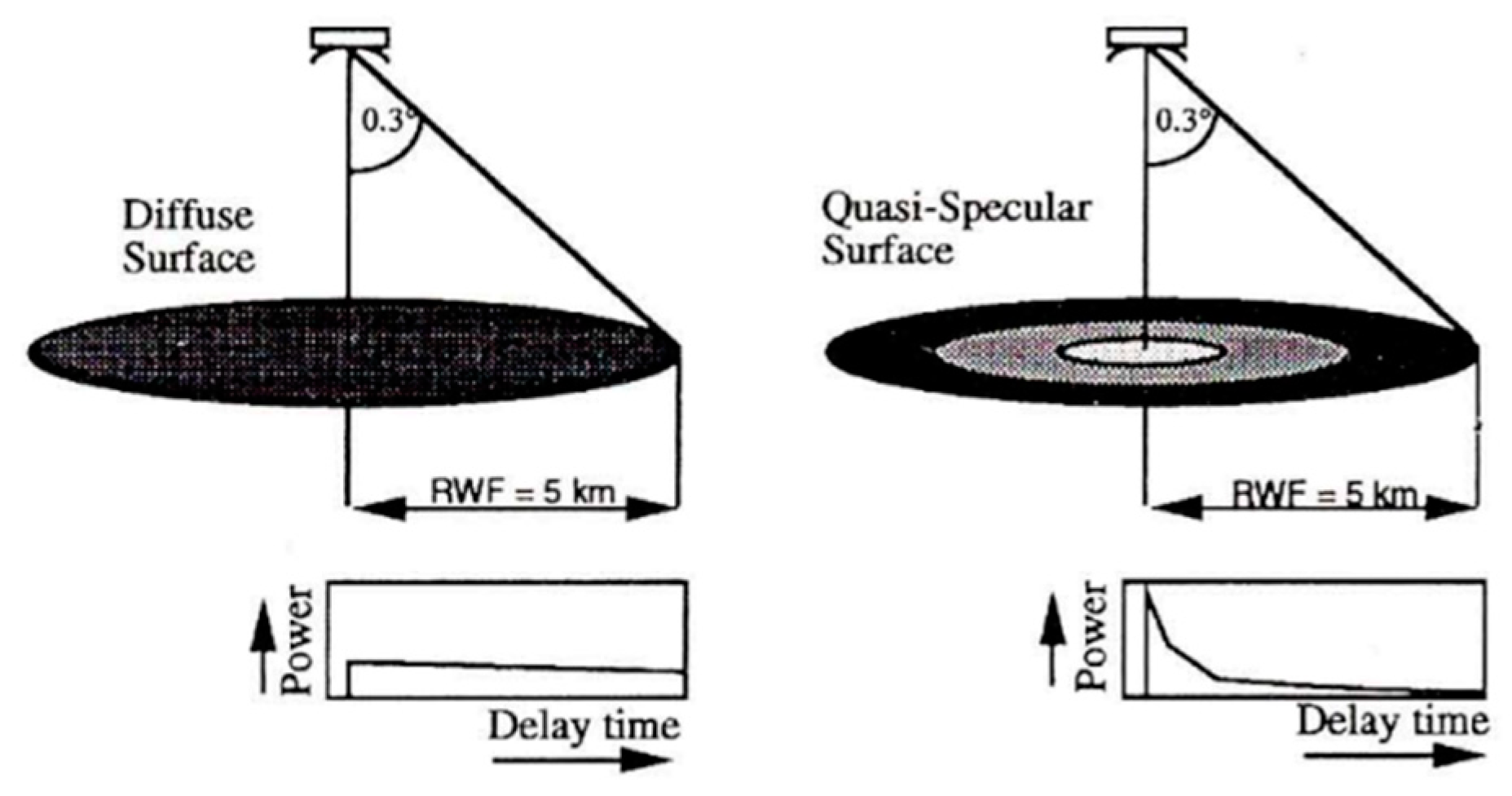
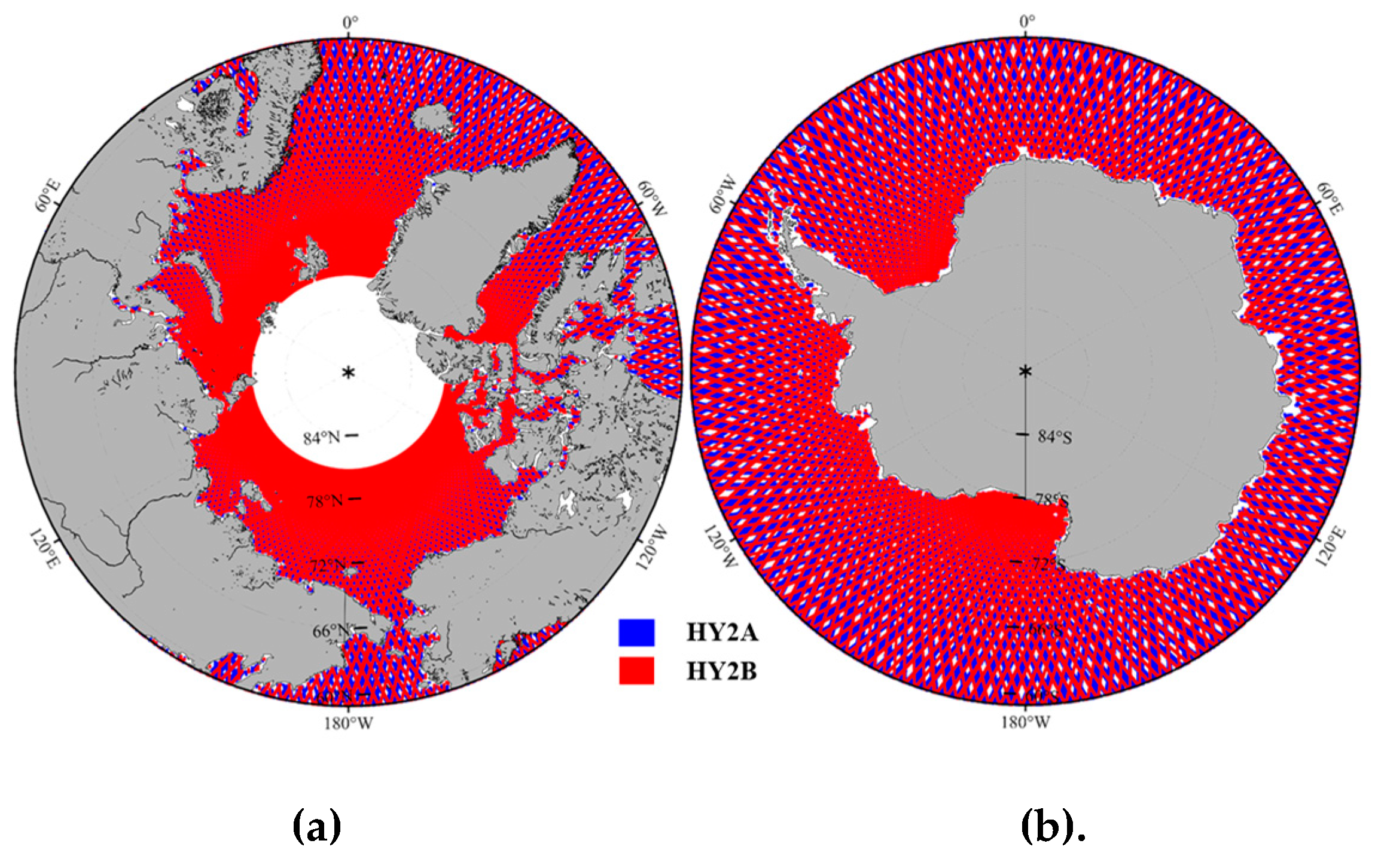

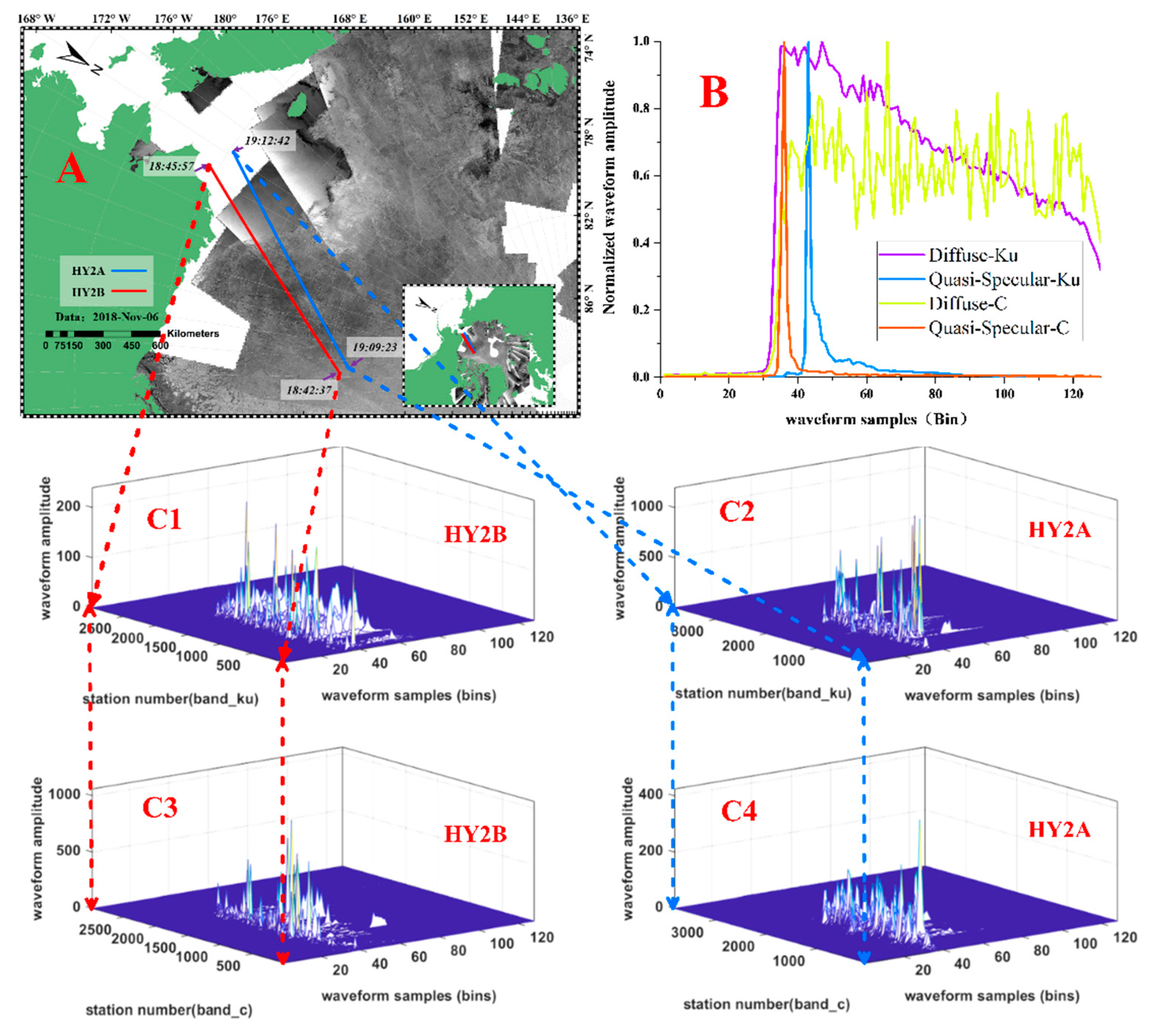

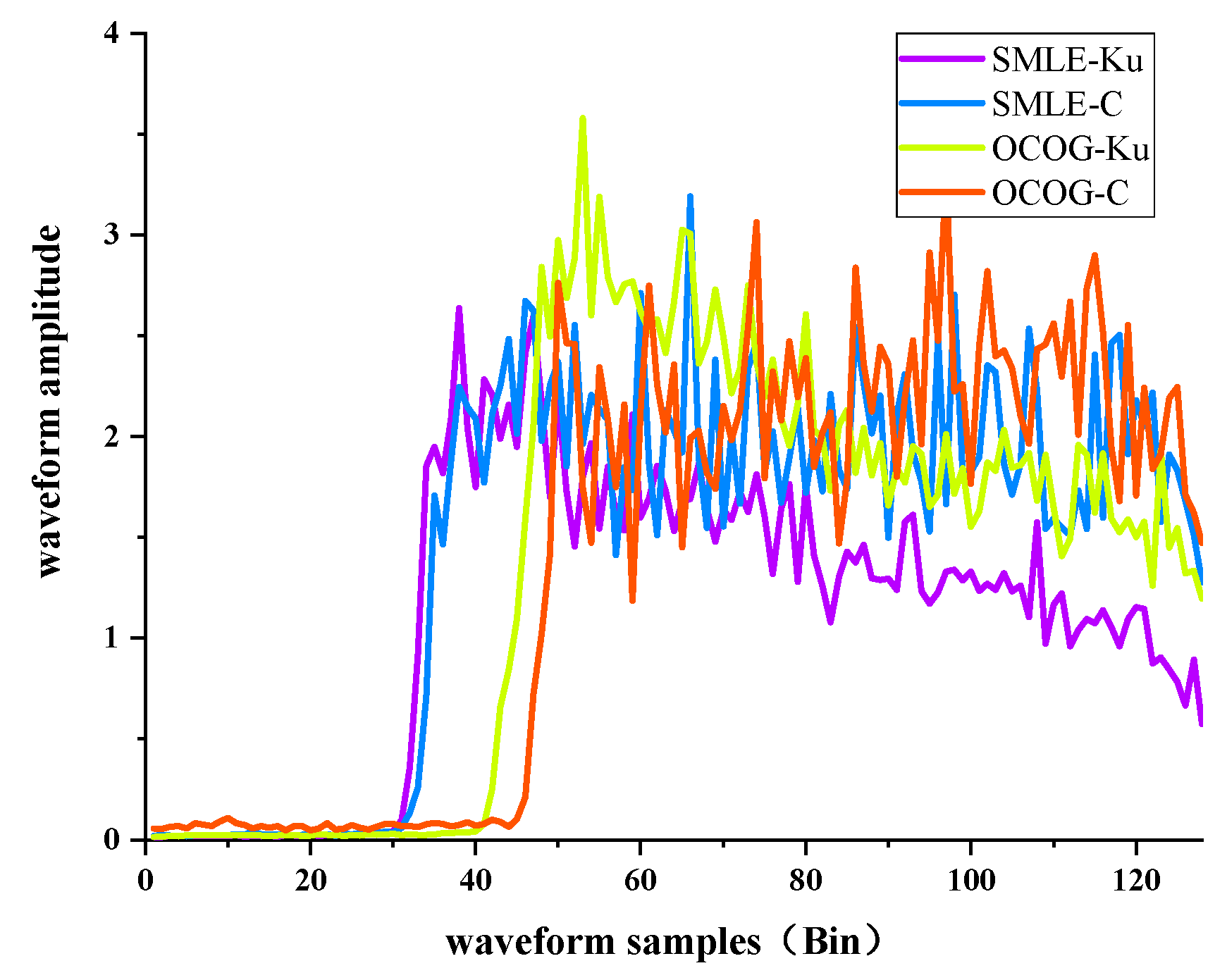

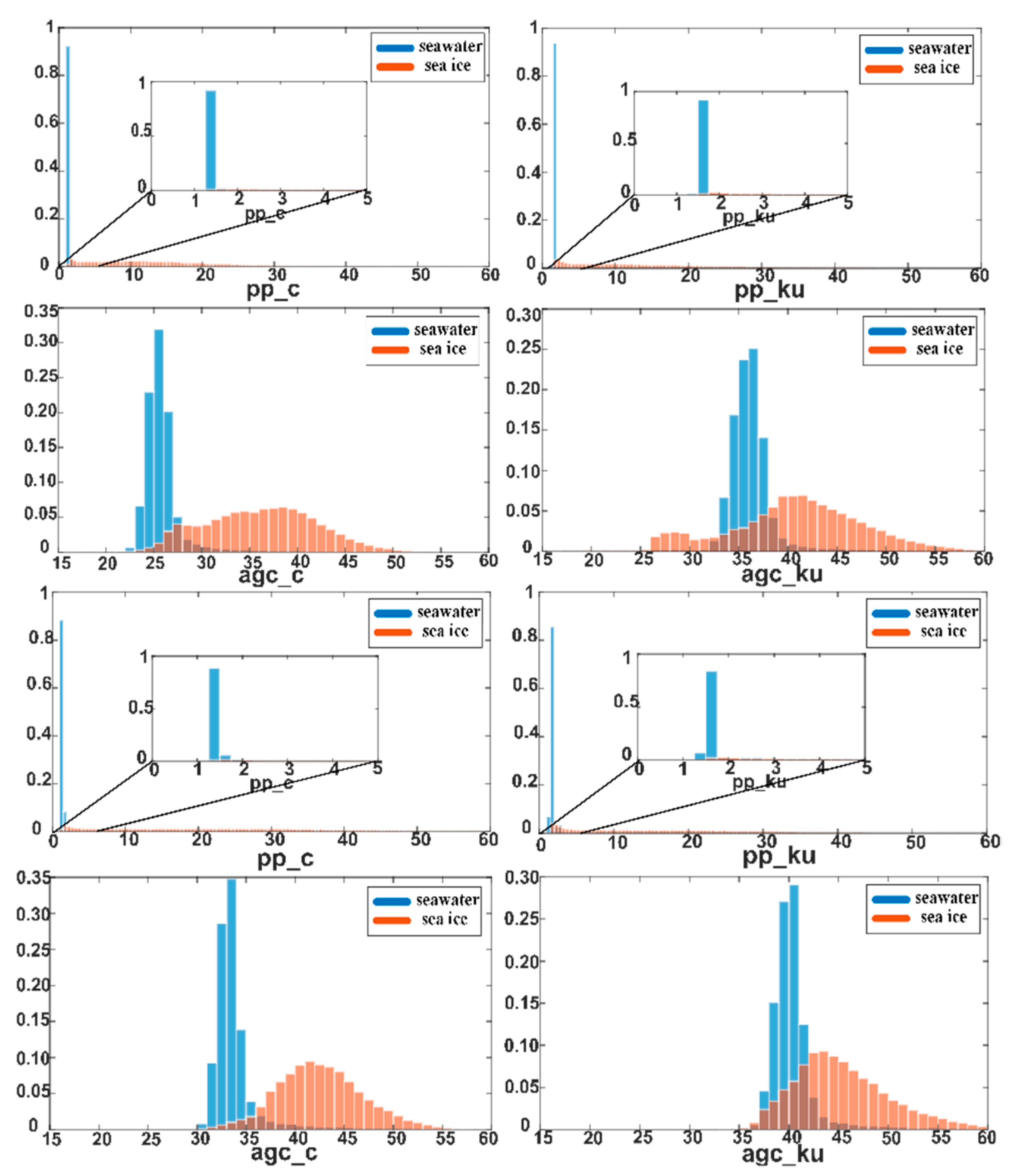

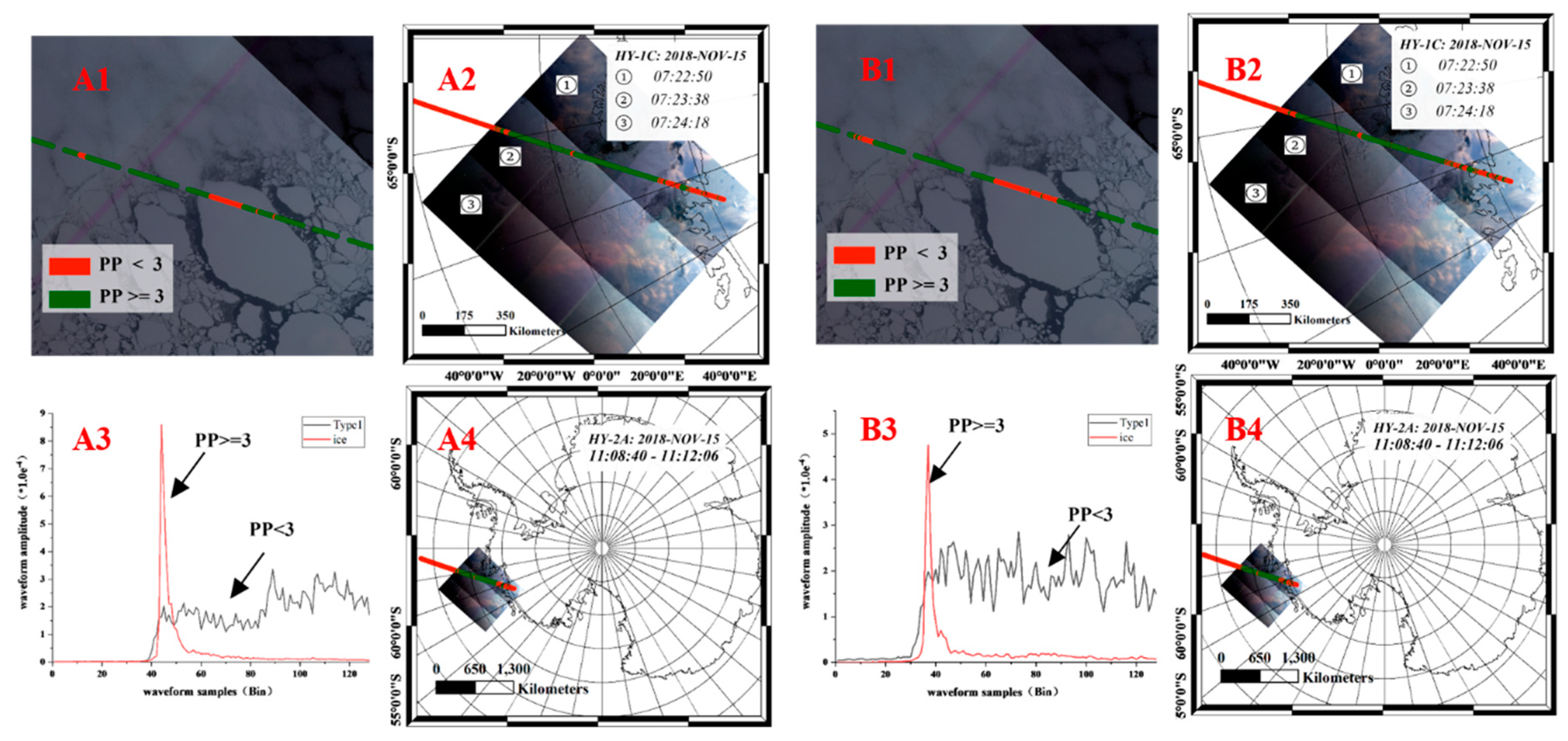
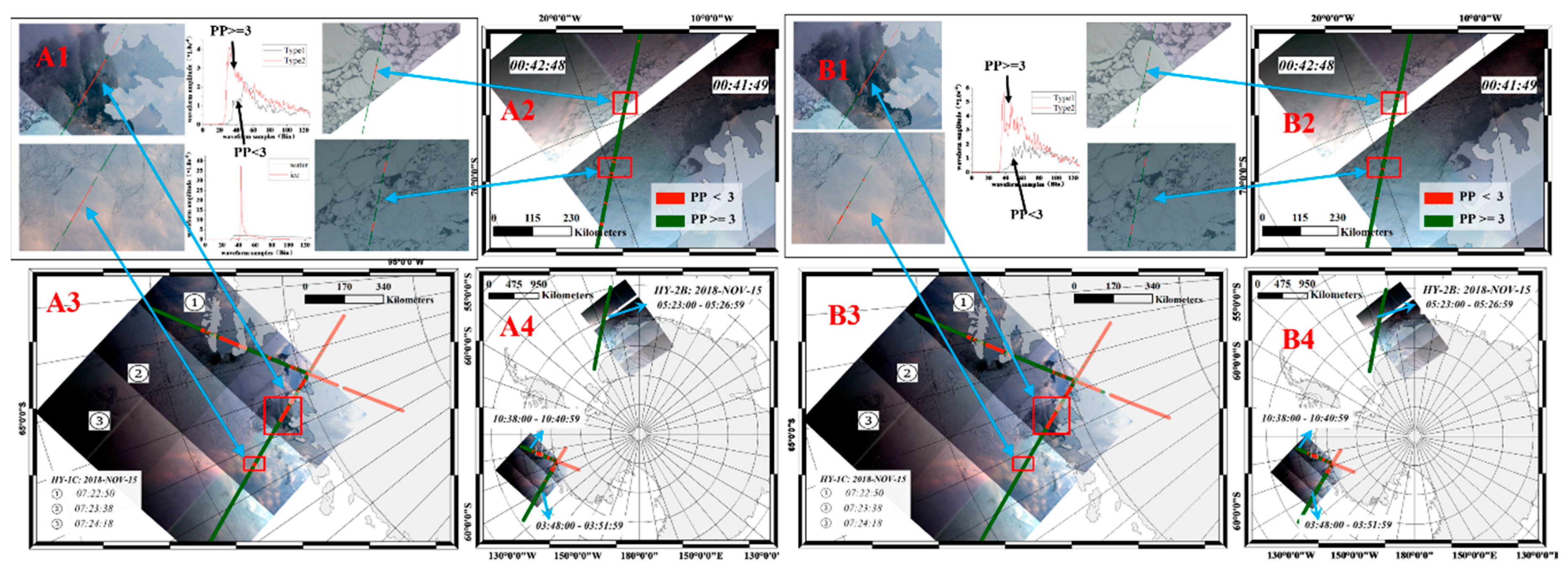
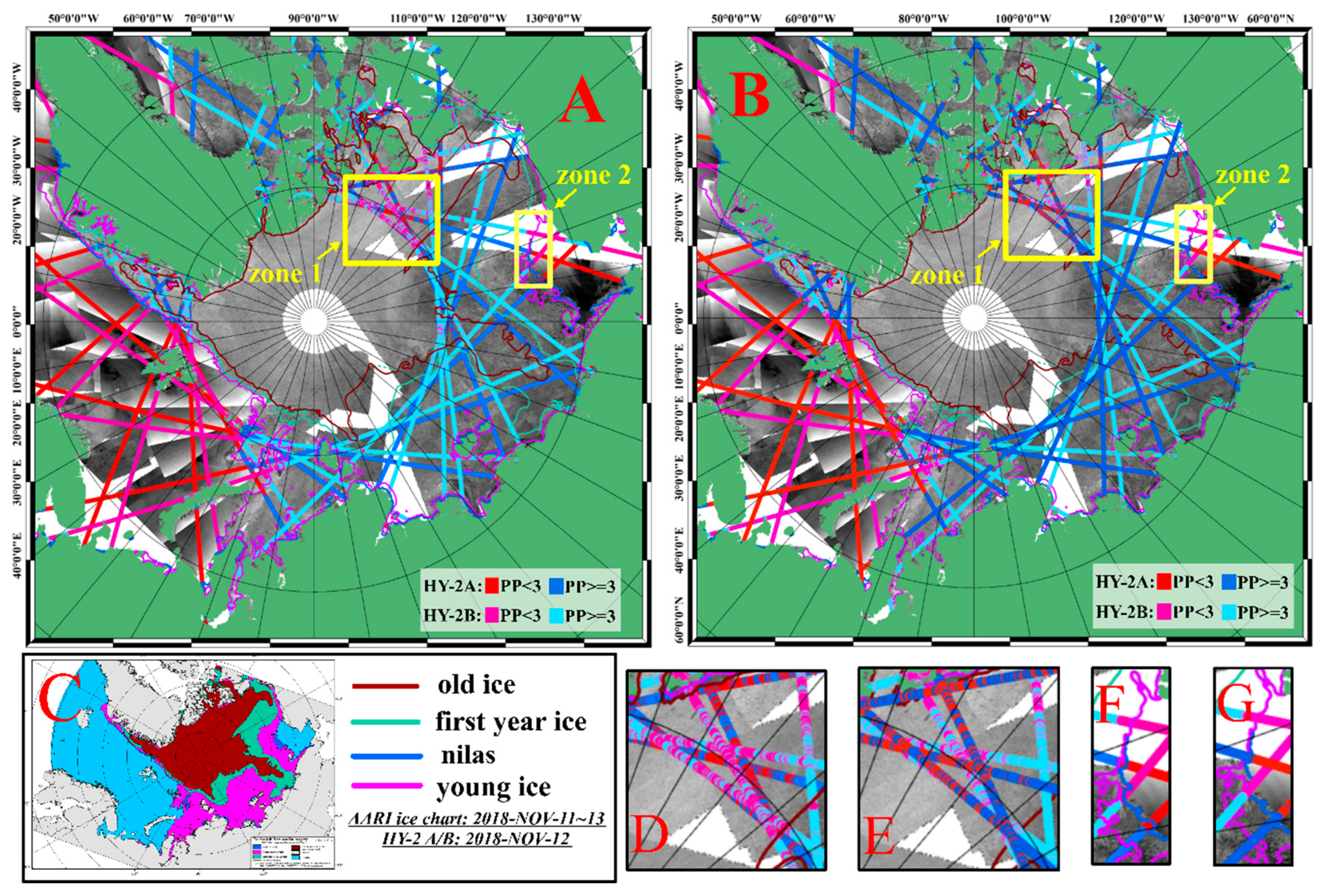
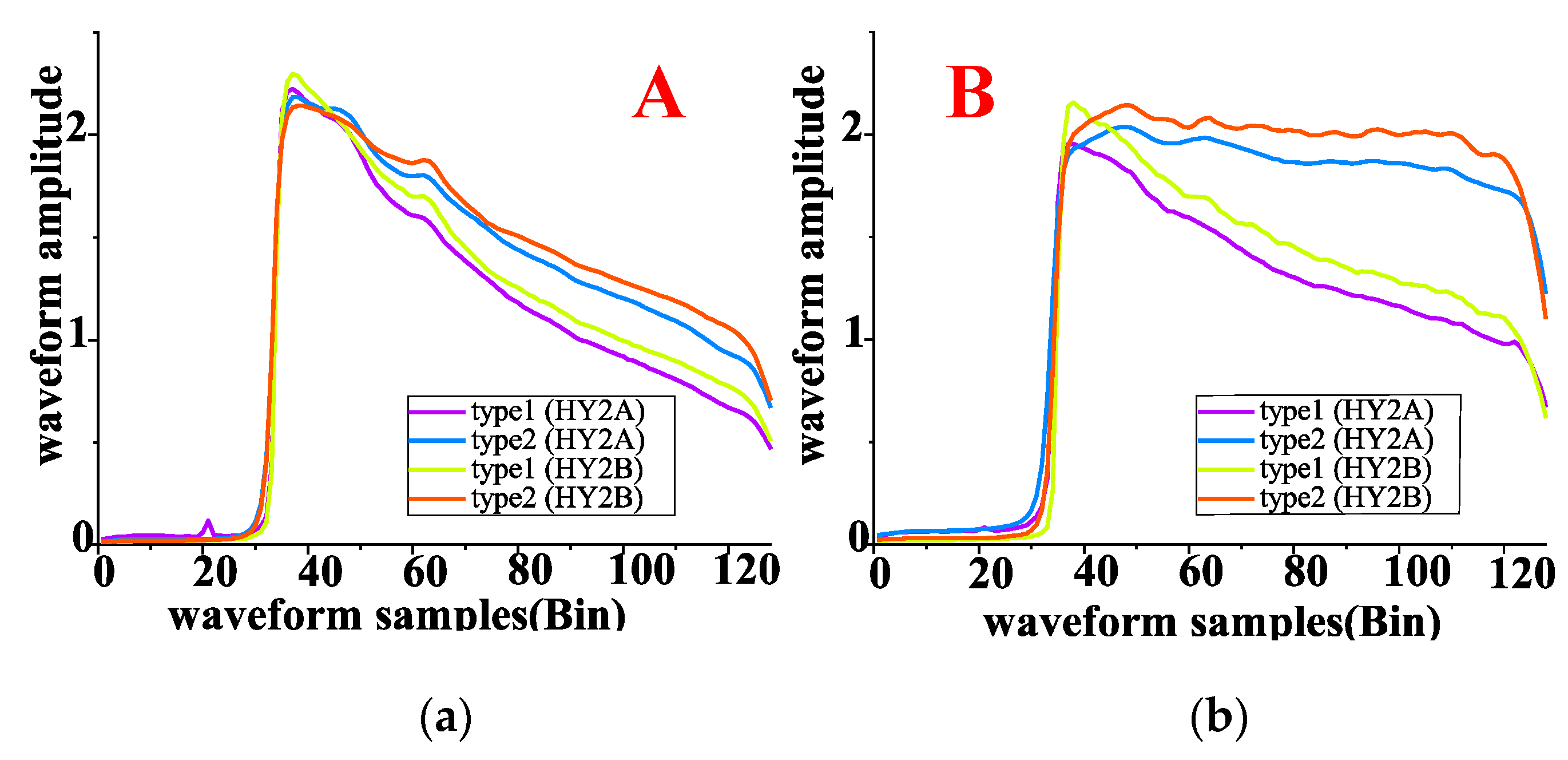
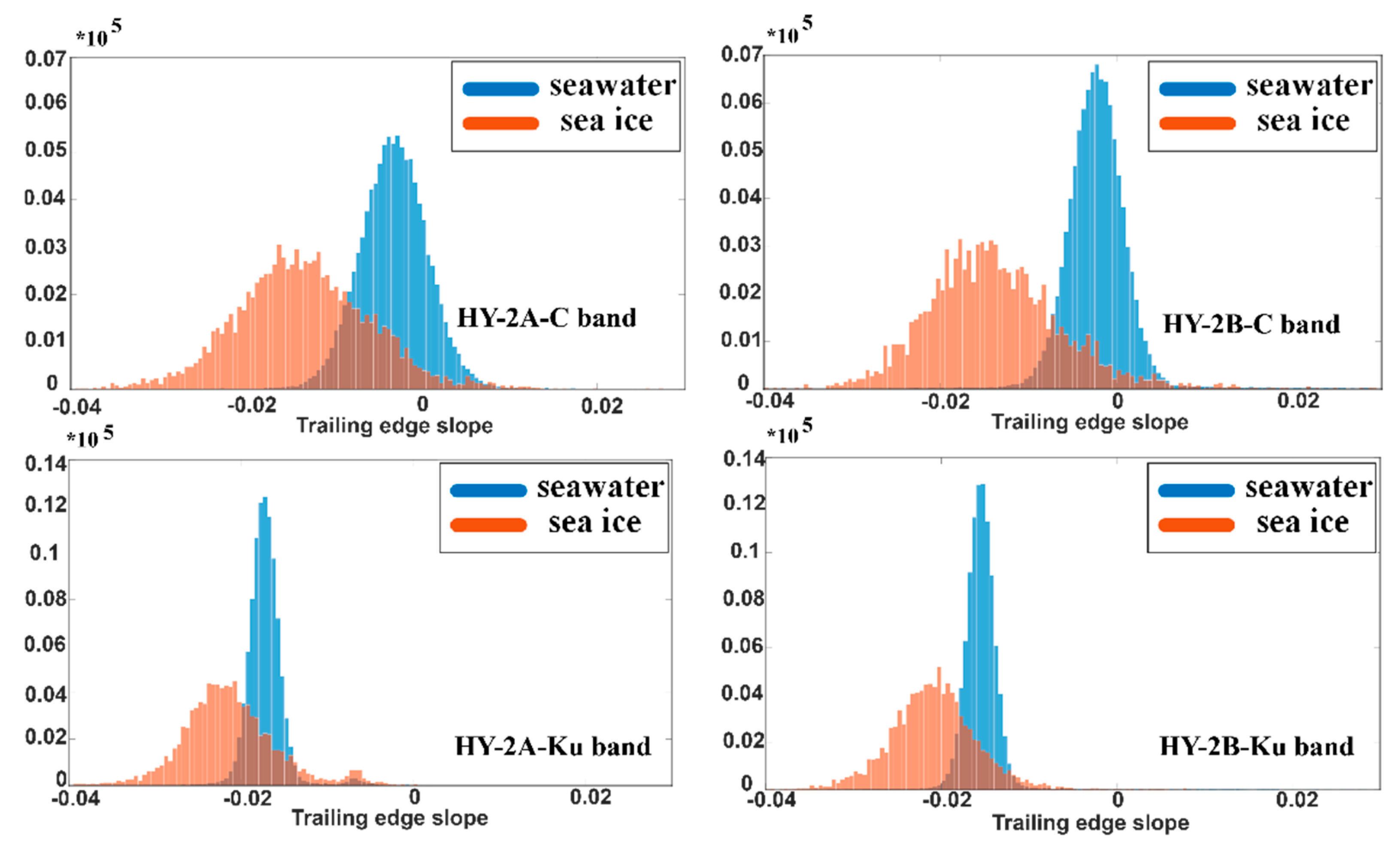
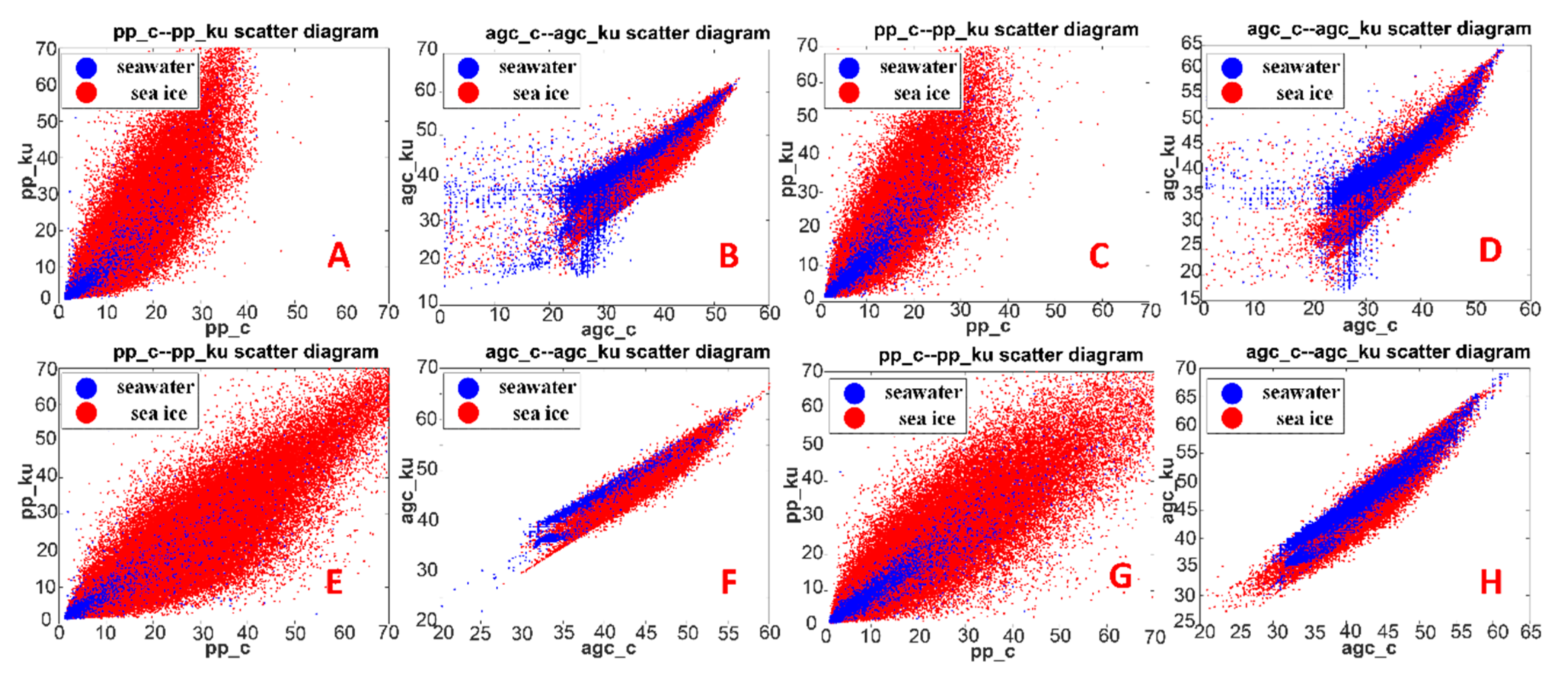
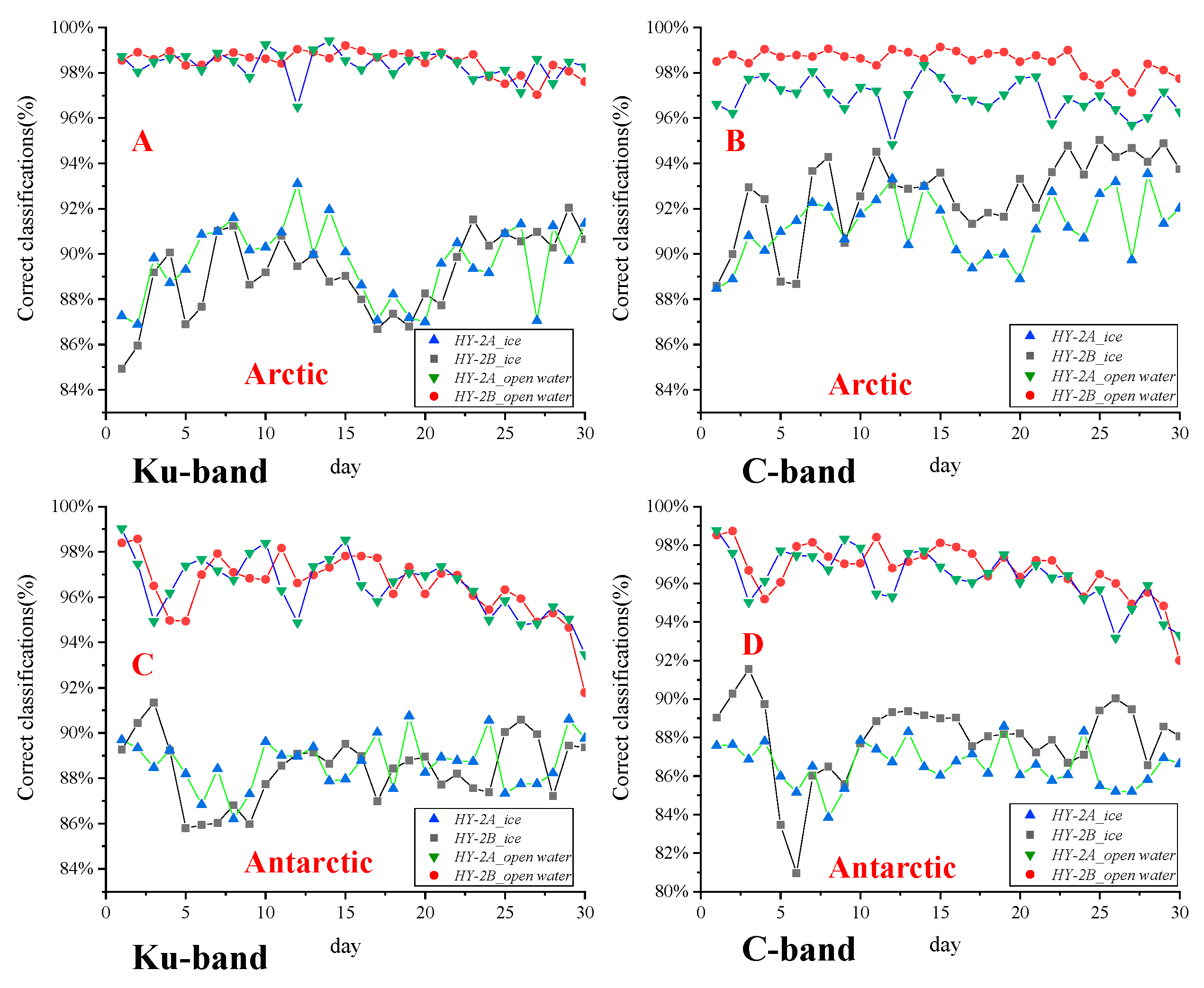




| Items | Values | |
|---|---|---|
| Emission signal center frequencies | 13.58 GHz | 5.25 GHz |
| Bandwidth | 102.4 us | |
| AGC dynamic range | 60 dB | |
| Fast Fourier Transform bin number | 128 | |
| Transmitter peak power | ≥10 w | ≥20 w |
| Chirp signal band width | Ku: 320/80/20 MHz (three bandwidths for adaptive adjustments) | |
| C: 160/40/10 MHz (three bandwidths for adaptive adjustments) | ||
| Type | PP (Ku/C) |
|---|---|
| Ice | <3 |
| Water | > = 3 |
| Satellite | Band | Sea Ice | Seawater | |
|---|---|---|---|---|
| Arctic | HY2A | C | 89.86% | 96.22% |
| Ku | 88.28% | 96.32% | ||
| HY2B | C | 92.33% | 97.85% | |
| Ku | 88.89% | 98.37% | ||
| Antarctic | HY2A | C | 86.55% | 96.27% |
| Ku | 88.66% | 96.49% | ||
| HY2B | C | 87.93% | 96.09% | |
| Ku | 88.42% | 95.85% |
| Satellite | Band | Sea Ice | Seawater | |
|---|---|---|---|---|
| Arctic | HY2A | C | 87.66% | 95.39% |
| Ku | 85.76% | 98.36% | ||
| HY2B | C | 92.54% | 98.01% | |
| Ku | 87.81% | 97.32% | ||
| Antarctic | HY2A | C | 94.01% | 14.36% |
| Ku | 82.52% | 37.71% | ||
| HY2B | C | 79.78% | 15.57% | |
| Ku | 92.94% | 91.98% |
© 2019 by the authors. Licensee MDPI, Basel, Switzerland. This article is an open access article distributed under the terms and conditions of the Creative Commons Attribution (CC BY) license (http://creativecommons.org/licenses/by/4.0/).
Share and Cite
Jiang, C.; Lin, M.; Wei, H. A Study of the Technology Used to Distinguish Sea Ice and Seawater on the Haiyang-2A/B (HY-2A/B) Altimeter Data. Remote Sens. 2019, 11, 1490. https://doi.org/10.3390/rs11121490
Jiang C, Lin M, Wei H. A Study of the Technology Used to Distinguish Sea Ice and Seawater on the Haiyang-2A/B (HY-2A/B) Altimeter Data. Remote Sensing. 2019; 11(12):1490. https://doi.org/10.3390/rs11121490
Chicago/Turabian StyleJiang, Chengfei, Mingsen Lin, and Hao Wei. 2019. "A Study of the Technology Used to Distinguish Sea Ice and Seawater on the Haiyang-2A/B (HY-2A/B) Altimeter Data" Remote Sensing 11, no. 12: 1490. https://doi.org/10.3390/rs11121490



